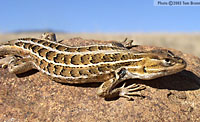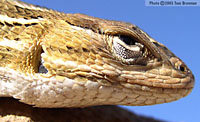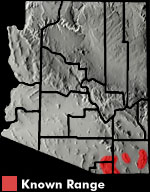Online Field Guide to The Reptiles and Amphibians of Arizona


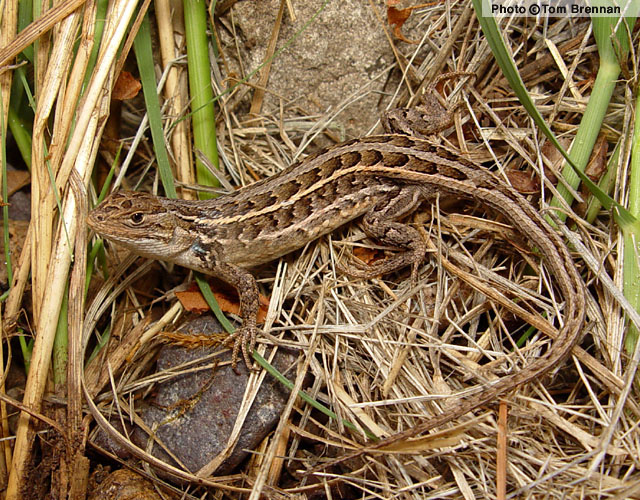
Cochise County, AZ
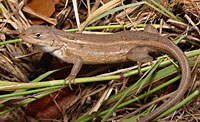 Plain form. Cochise Co., AZ |
| SLEVIN’S BUNCHGRASS LIZARD Sceloporus slevini | |
|
DESCRIPTION: A small (up to 68 mm or 2.7″ from snout to vent), tan, gray-brown, or yellow-brown lizard with a broad, gray mid-dorsal stripe and a light stripe on each upper side. The lower sides are often tinted with orange. Some individuals are boldly patterned and others are relatively plain. Boldly patterned animals have dark, crescent-shaped body blotches, crisp-edged stripes on the back, and a dark patch with a light blue center on each shoulder. The back edge of each body blotch is often trimmed with a thin, light line. Plain individuals are generally gray-brown, lack blotches, and have only faint, soft-edged stripes. Males often have two blue bars on the belly. The scales are pointed, keeled, and overlap like shingles. The scale rows on the sides of the body are horizontal (spines point straight back). All other Sceloporus in Arizona have diagonal scale rows on the sides of the body (spines point up and back). HABITAT: Mountain populations inhabit Madrean Evergreen Woodland, Petran Montane Conifer Forest, and Petran Subalpine Conifer Forest communities. In the valleys of eastern Santa Cruz County it is found in Plains Grassland. It is usually encountered in open, sunny areas with abundant bunch grass. DIET: Slevin’s Bunchgrass Lizard eats a variety of insects including true bugs, ants, beetles, wasps, and grasshoppers. It also eats spiders. REPRODUCTION: This lizard mates in April and lays a clutch of up to 13 eggs in June, July, or August. Hatchlings emerge in August and September. REMARKS: Heavy grazing has been linked to severe declines in populations of this lizard. In southeastern Arizona grasslands it was found to be common in ungrazed areas but was virtually absent from adjacent grazed parcels. By Thomas C. Brennan Brennan, T. C., & A. T. Holycross. 2006. A Field Guide to Amphibians and Reptiles in Arizona. Arizona Game and Fish Department. Phoenix, AZ Degenhardt, W. G., Painter, C. W., and Price, A. H.. 1996. Amphibians and Reptiles of New Mexico. University of New Mexico Press. Albuquerque. Stebbins, R.C. 2003. A Field Guide to Western Reptiles and Amphibians, Third Edition. Houghton Mifflin Company, Boston, MA. |
|
Visit Partners in Amphibian and Reptile Conservation:


HOME
Copyright © 2023, Arizona Game and Fish Department. All rights reserved.
If you make use of the textual contents of this site in reports, publications, etc. please cite and credit the author(s) and photographer(s). All photos on this website are copyrighted. However, those found in the species account section may be used for any noncommercial scientific, educational, or conservation purposes provided that photographs are not altered and continue to bear the copyright symbol and name of the photographer. Please contact the photographer regarding commercial use of copyrighted photographs.










